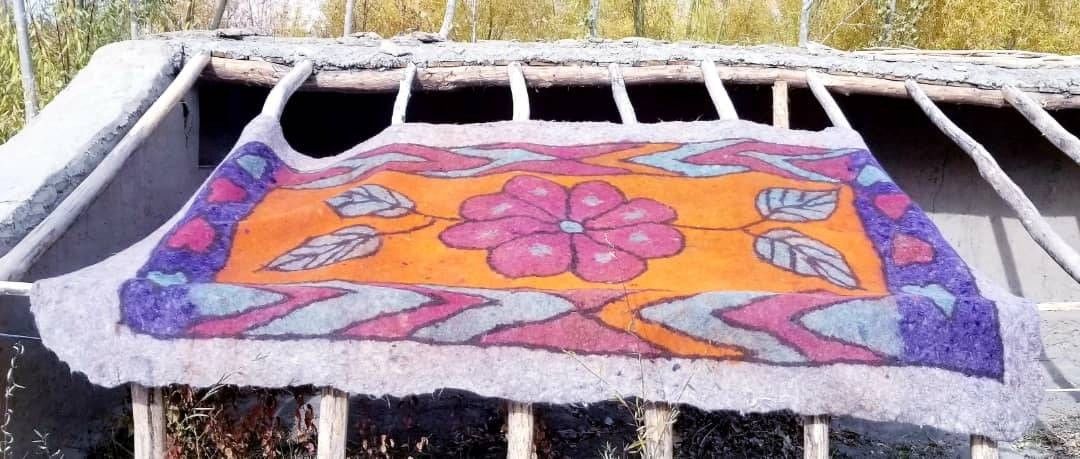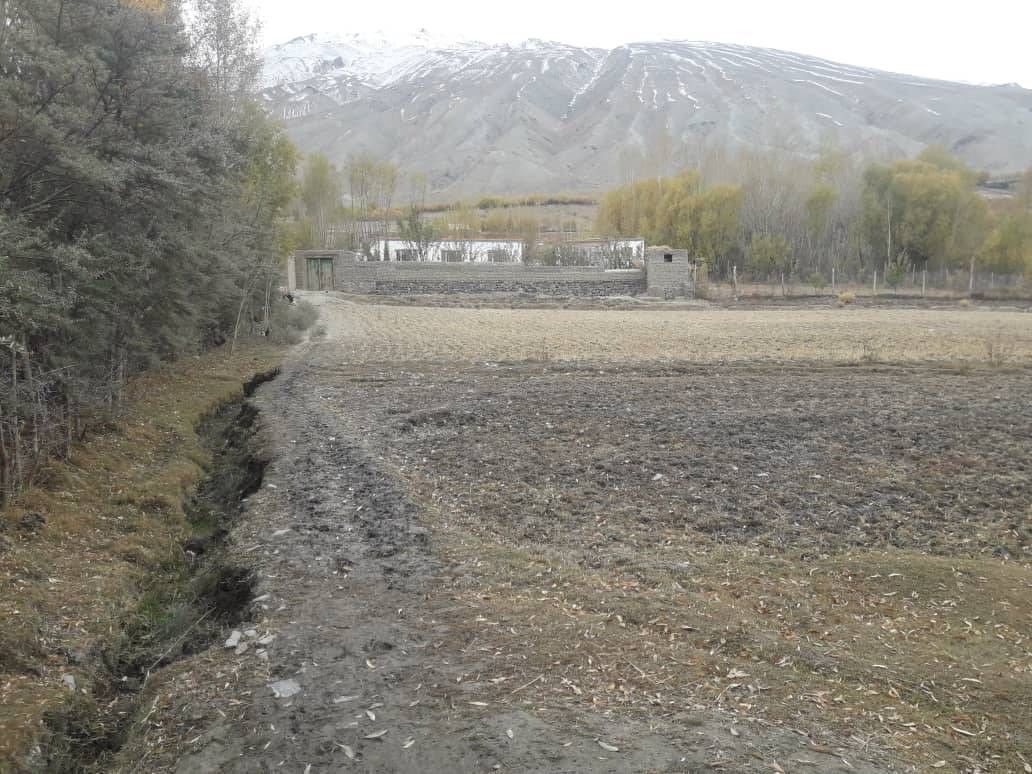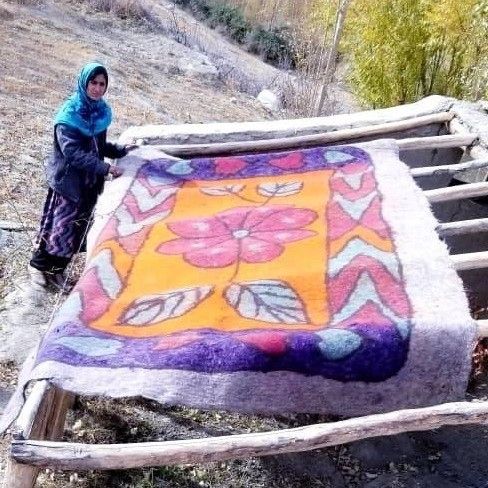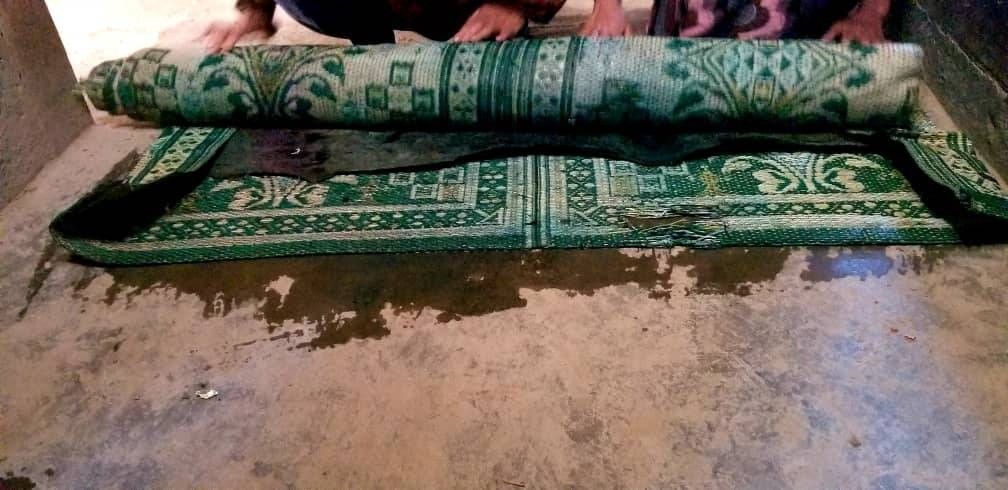Namad Bafi — a Handicraft for the Mountains

— One Day in Afghanistan —
Reporting by Safoora Suhail, edited by Mohammad J. Alizada and Brian J. Conley
Ishkashim — Handicrafts portray the culture of a country and show the ability and competence of her people. When it comes to Afghanistan, her handicrafts are among the best in the world. Although the country is riddled with war and poverty, the beauty of its handicrafts cannot be missed, nor ignored.
The same is true of the handicrafts from the northeastern province of Badakhshan. Namad Bafi, “mat weaving”, is part of the handicraft culture in the beautiful northeastern province. Today we are in the village of Osas in Ishkashim district of Badakhshan province. Osas is about 7 hours southeast of Faizabad, Badakhshan’s capital, near the border with Tajikistan.
I arrive at Adina Bibi’s home around 8 am after walking through hills and agricultural lands. Adina opens the door and we go inside her house. Her house is fairly large in size, built in the corner of their land, near a mountain now covered with snow. The outer walls of the house are built with stones and bricks while the rooms are built with concrete. Adina’s house consists of 5 rooms, to include the kitchen, a guest room, two rooms for her daughters and sons and one room used for the felting machine.

Ms. Adina and I are standing in the middle of her house and her chickens are busy tearing leaves strewn in her yard looking for something to eat beneath the leaves. Birds keep flying around from tree to tree, chirping and singing their tone, a peaceful melody to the ears. A girl is sweeping the leaves that have fallen in the night in the corner of the house with the rooms.
Adina Bibi is 48 years-old and is married to 56 year-old Sayed Abdul Karim, they have six children, four boys, and two girls. Sayed Agha Jan is 25 and studying in Pakistan, Sayed Rahim is 20 years-old finishing high school this year, Sediqah (girl) is 18 and in 10th grade, Sayed Shahryar is 16 in 8th grade, Esfandyar is 15 and 7th grade, and the smallest child Salma (girl) is 3 years-old.

Time passes by without notice and now is 9 am. Adina and I enter her workshop. One of the corners of her room is full of wool and the other is occupied by the felting machine. Although it is no longer season for weaving mats, Ms. Adina wants to make one for her own home with a width of 1.5 meters and height of 2 meters.
The boys’ school is some five kilometers from their home. Adina asks Sediqah if the boys have gone to school and she responds yes with sorrow. With the Taliban takeover of Afghanistan mid-August this year, Sediqah can no longer go to school and her hopes and interests are now buried. The concern for Sediqah’s future can also be seen on Adina’s face.
The Taliban are yet to allow women in Afghanistan to return to work and girls’ schools above 6th grade remain closed in many provinces. Women who once worked and went to university across the country are stuck at home with an uncertain future.
Adina takes me to the workshop and turns the diesel-powered felting machine on with the help of her husband and puts some wool through the machine. Most of the wool is white with some black.
“I must now color some of the wool so I can use it to make the mat,” Adina Bibi says in an interview with Alive in Afghanistan while busy in her workshop. There are two buckets of orange and purple in the workshop that she uses to color the white wool.
Adina says, “most of the wool is painted according to the customer’s orders but sometimes I use my own favorite colors to make the mats.”
After the coloring is done, Adina Bibi starts twisting some black wool between her frail hands with speed, which makes it look like her hands are dancing. Adina will use the twisted wool as the border and the skeleton for her mat.
She completes the borders and the design and starts placing various colors of wool inside the borders.
“I have to make the wool sit as low as possible after filling it in so we can wrap it around a circular piece of wood,” Adina says while laying the wool down and pressing on top of it to make it sit firmly. She fills up a bucket with hot water and uses a broom to pour the water on the wool, which will make the wool sit more firmly and stick.
She gets the wool for her mats from shaving the sheep they tend. Families who want her to make mats for her usually bring in their own wool. Adina Bibi also makes mats out of wool from the animals they own and sells it to her customers.
The amount of wool needed to make a mat depends on the size, the mat she is making today requires 20 kg of wool.
Adina now tightly wraps the incomplete mat that is sitting on top of a green and black colored plastic mat around the round wooden stick and ties a rope around it that can be pulled from both sides. They lay the wrapped mat on the floor and start pulling on each end of the rope on both sides so the mat is moving in a circular motion on the ground to take shape.
“Namad (Felt) is the enemy of Rheumatism and the best method of expulsion of moisture and cold,” Adina Bibi says adding that, “namad is normally warm and a product that is used in cold climates like the one in Badakhshan and the province’s Pamir mountains with high altitude.”
It’s now 11:30 and Adina looks tired. She invites me to have lunch with them. Sediqah lays a colorful linen in the guest room and brings in her deliciously cooked rice, which both Adina and I eat with fervor due to our hunger. Sediqah eats with her father in another room after serving us.
After eating lunch and performing the noon prayer, it’s now 1 pm and Adina gets back to work. Adina unties the ropes and brings the mat inside the workshop. Adina and Marina, a 52 year-old neighbor, now roll the wrapped mat on the ground with their hands.
“I receive orders from different provinces, even foreigners who come here for tourism order mats,” Adina says while busy rolling the mat with Marina.
Adina pays female neighbors for help when she has a lot of orders but she doesn’t talk about the amount she pays them.

They must roll the mat like this, with their hands, for two hours so all the wool is weaved together and the mat is as flat as possible. After completing the process, Adina Bibi takes the mat and lays it down on pieces of wood for it to dry, not far from her home. The colorful flower pattern she designed earlier can now be clearly seen.

“It’s a tradition in Badakhshan that the mother of the bride either makes a mat for her daughter or orders one to give as a gift for her daughter,” Adina Bibi says. The mats that she makes can cost up to 20,000 Afghanis ($220).
These mats are part of Afghanistan’s traditional handicrafts from ages ago that is made not just in Badakhshan, but in many of the provinces with a colder climate across the country.
Other handicrafts of the same type include Kilim (area rug) and Qaleen (pile rug), both of which require a much longer time period to be completed, each depending on the size.
